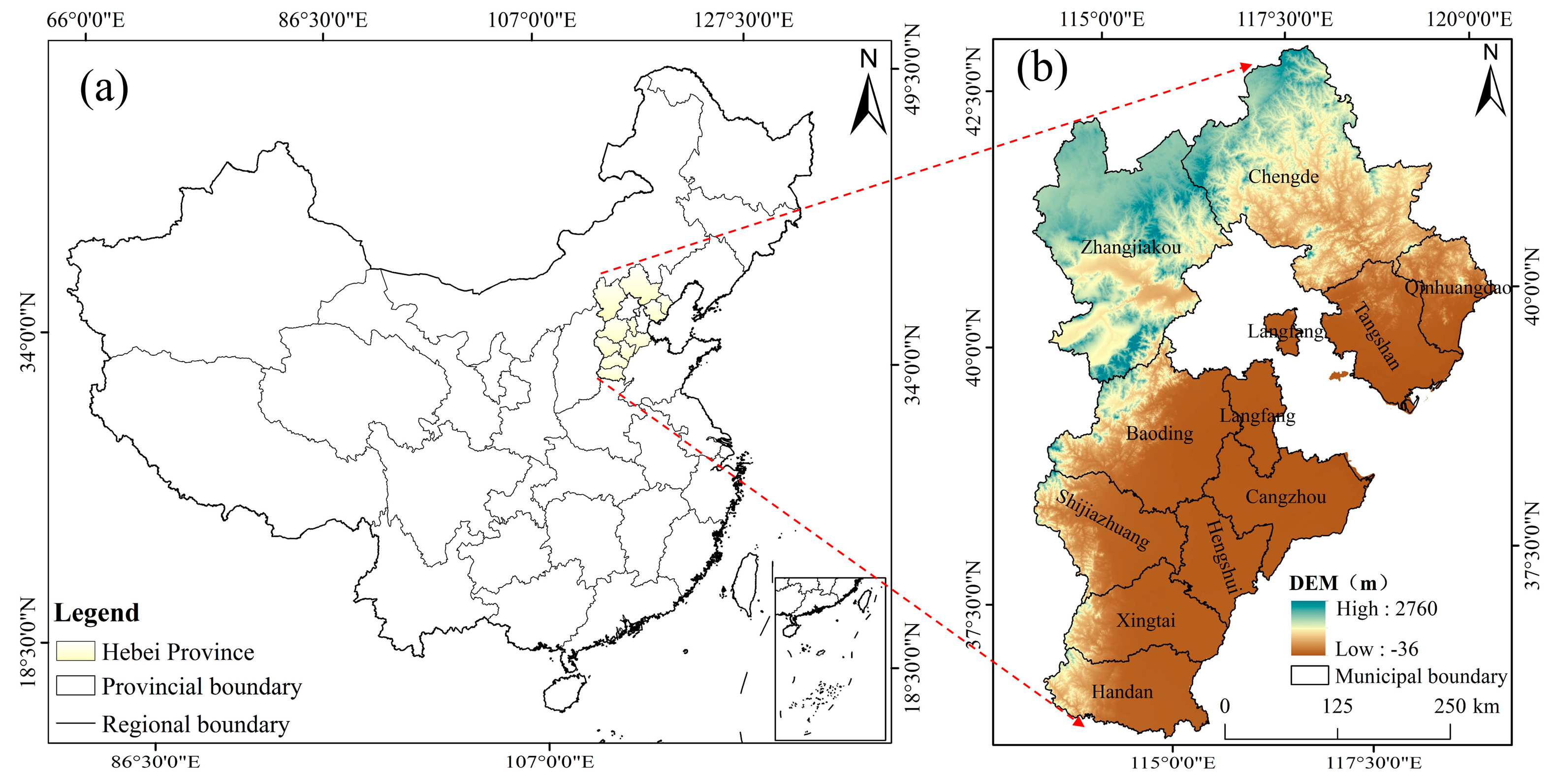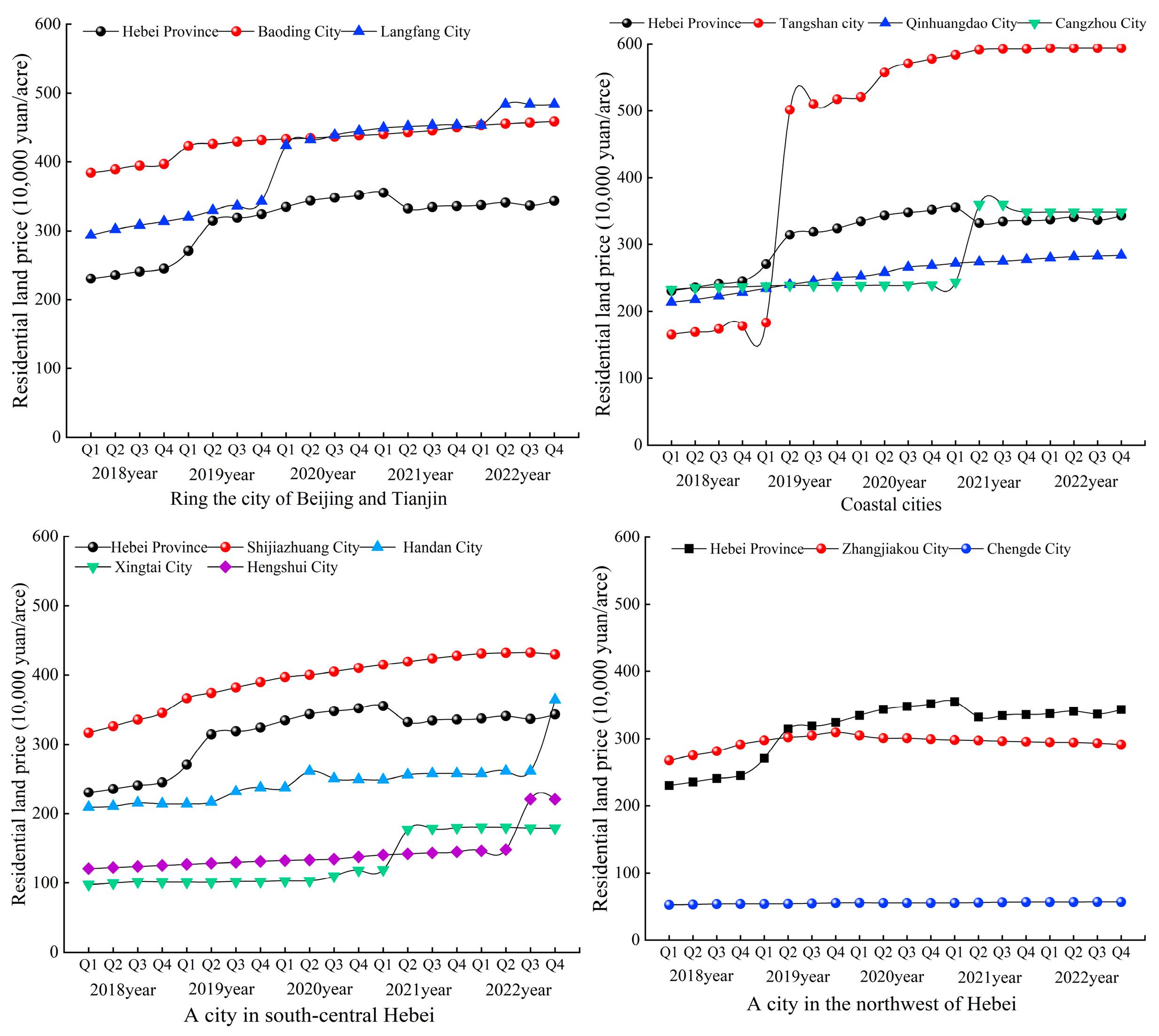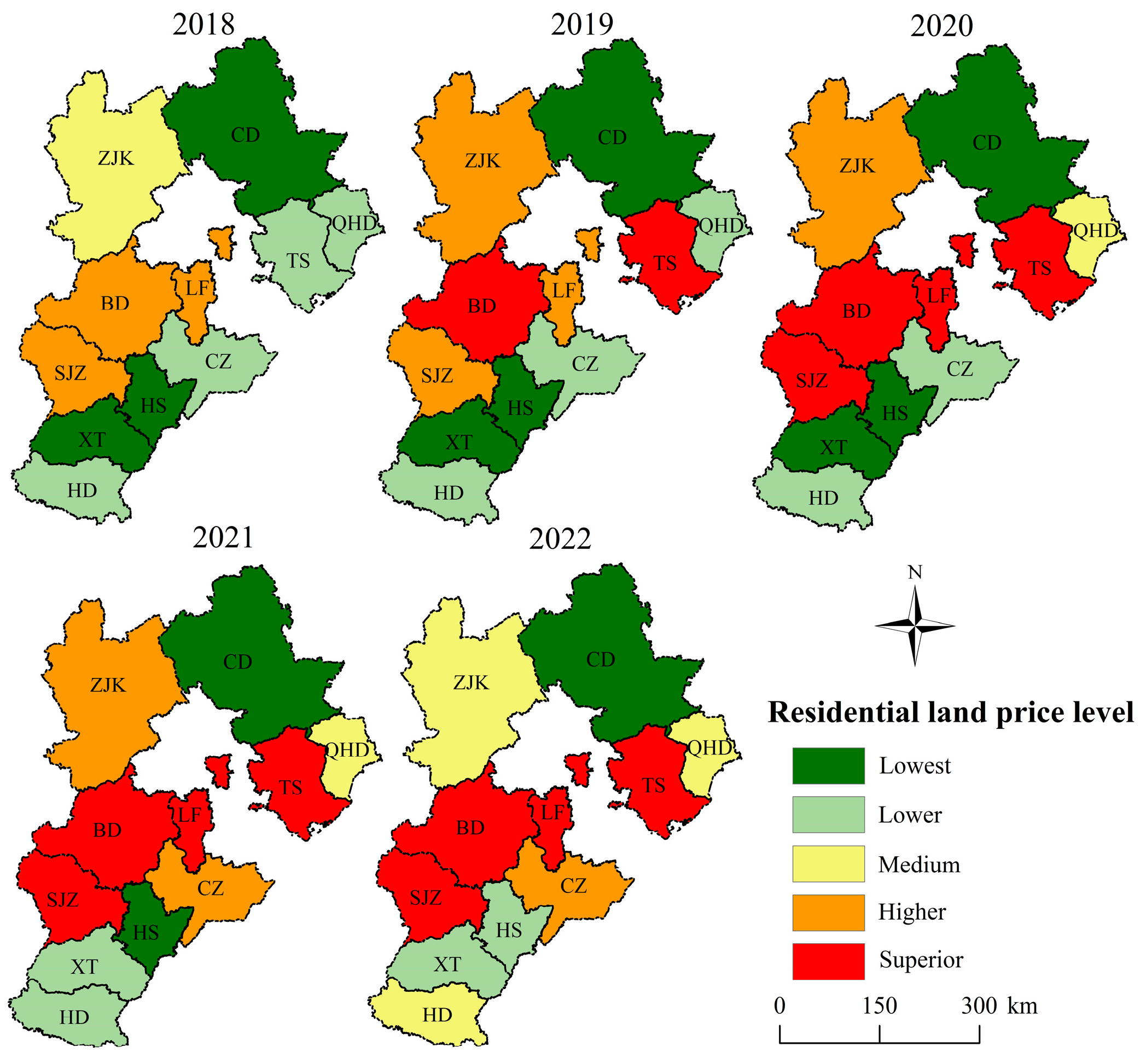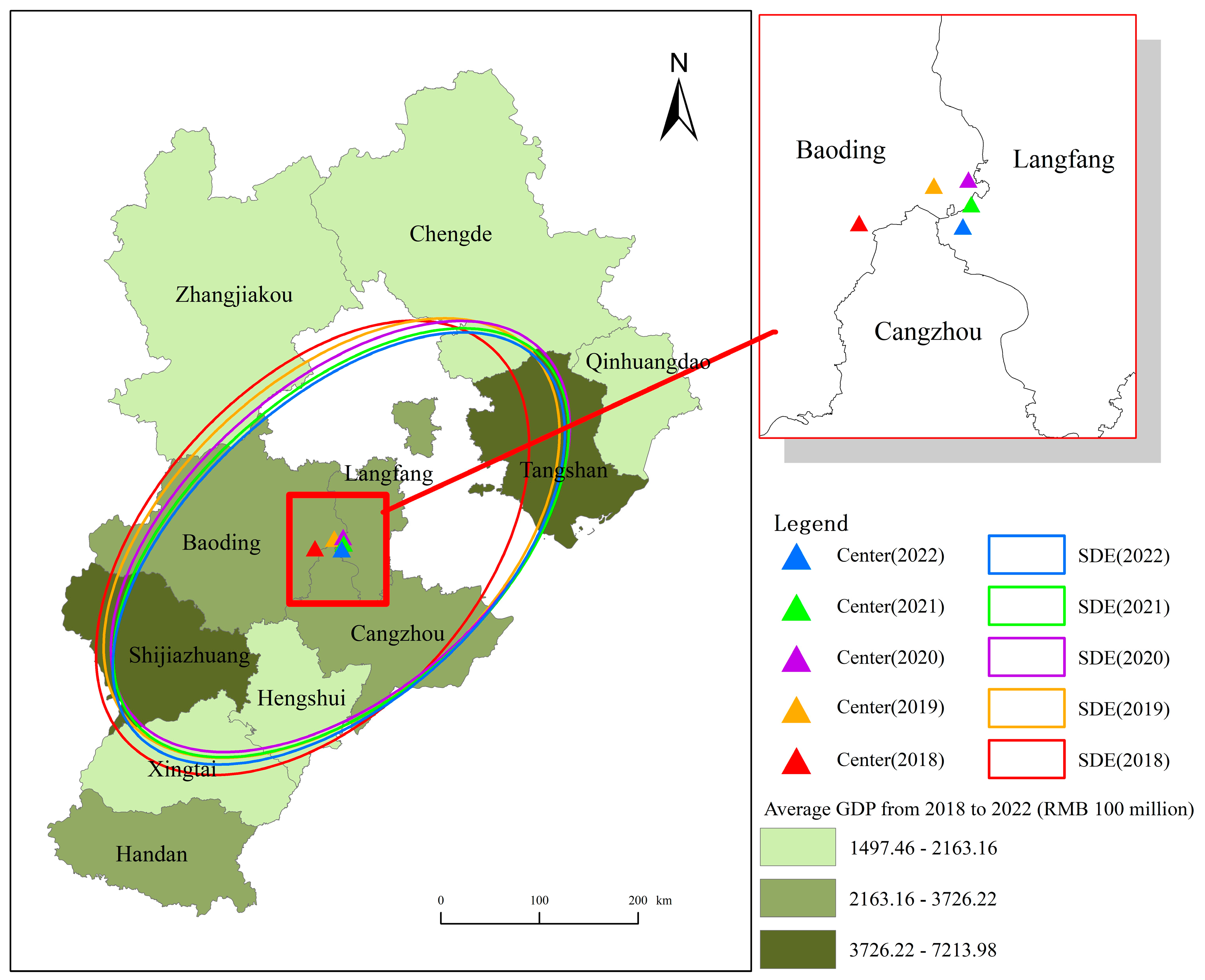The Spatio-Temporal Development and Influencing Factors of Urban Residential Land Prices in Hebei Province, China
Abstract
:1. Introduction
2. Overview of the Study Area and Data Sources
2.1. Overview of the Study Area
2.2. Data Sources
3. Methodology
3.1. Theil Index
3.2. Standard Deviation Ellipse Method
3.3. Geographical Detector Model
3.4. Indicator Selection
4. Results
4.1. Changes in Residential Land Prices in Cities in Hebei Province
4.1.1. Temporal Characteristics of Urban Residential Land Prices
4.1.2. Spatial Distribution Features of Urban Residential Land Prices
4.1.3. Analysis of Spatial Differences in Urban Residential Land Prices
4.2. Evolution of Spatial Patterns Based on Standard Deviation Ellipses
4.3. Analysis of Factors Influencing Urban Residential Land Prices in Hebei Province
4.3.1. Single-Factor Detection Results
4.3.2. Interactive Detection Results
5. Discussion
5.1. Driving Mechanism of Urban Residential Land Prices
5.2. Management and Enlightenment of Urban Residential Land Price
- (1)
- Explore diverse residential land market regulation policies and establish a city cluster for the coordinated development of urban residential land prices. Given the uneven development among cities in Hebei Province, relevant government departments should integrate factors such as urban economic growth, functional zoning, industrial structure, and variations in land prices into urban development planning strategies. Confronted with the rapid escalation of urban residential land prices in central cities like Shijiazhuang, Baoding, Langfang, and Tangshan, measures such as the equitable allocation of new construction land, the activation of dormant land, and the optimization of residential land usage should be implemented to ensure the sustainable growth of the urban residential market. For peripheral and mountainous cities experiencing slower growth in urban residential land prices, maximizing ecological resources, developing urban transport networks, and enhancing inter-city economic cooperation are crucial. By employing strategies such as industrial structure adjustments and incentives for talent retention, the balanced development of urban residential land prices can be achieved.
- (2)
- Accelerate the optimization of the residential land price network structure within cities and actively foster collaborative external networks. Hebei Province should extend outward from its central cities, leveraging connectivity advantages to develop intermediate centers like Cangzhou and Hengshui. Simultaneously, the province should establish corridors such as the “Shijiazhuang–Xingtai–Handan” corridor to expand external influence, fostering communication among city and county networks. Within the framework of “Beijing–Tianjin–Hebei coordinated development”, efforts should focus on enhancing intra-provincial transportation routes, facilitating connectivity between peripheral and central cities. Additionally, enhancing the transparency of land market information is crucial to ensure market participants’ awareness of trends and policy changes, promoting informed decision-making and fostering stable urban residential land prices.
5.3. Shortcomings and Prospects
6. Conclusions
- (1)
- Regarding temporal trends, residential land prices in Hebei Province of China exhibit an overall upward trajectory. Notably, Tangshan has experienced a pronounced surge, surpassing nearby cities near Beijing and Tianjin. Meanwhile, southern cities in central Hebei are also witnessing rapid growth, albeit from a lower base. Spatially, urban residential land prices demonstrate significant disparities, primarily concentrated in high-price areas along the Shijiazhuang–Baoding–Langfang–Tangshan axis, while low-price areas are predominantly located north and south of this axis. This spatial divide between high- and low-price areas is widening over time.
- (2)
- In terms of spatial evolution patterns, residential land prices across cities in Hebei Province of China exhibit a “northeast–southwest” distribution, aligning closely with the GDP distribution pattern. The movement center of land prices corresponds to the direction of urban land price increases in Hebei Province of China. The distribution of residential land prices tends to scatter along the long axis of the ellipse and concentrate along the short axis, indicating a strengthening directional trend in land pricing over time.
- (3)
- The prices of urban residential land in Hebei Province of China are determined by a complex interplay of factors, including urbanization level, economic development, geographic location, infrastructure, and city size. The synergistic effects between these factors often outweigh the impact of any single factor on land prices. Particularly influential is the proportion of third-industry GDP and geographical location conditions, which emerge as pivotal determinants shaping urban residential land prices in Hebei Province of China.
Author Contributions
Funding
Data Availability Statement
Conflicts of Interest
References
- An, P.; Li, C.; Duan, Y.; Ge, J.; Feng, X. Inter-metropolitan land price characteristics and pattern in the Beijing-Tianjin-Hebei urban agglomeration, China. PLoS ONE 2021, 16, e256710. [Google Scholar] [CrossRef] [PubMed]
- Gatzlaff, D.; Tirtiroğlu, D. Real estate market efficiency: Issues and evidence. J. Real Estate Lit. 1995, 3, 157–189. [Google Scholar] [CrossRef]
- Chen, F. Spatial differentiation of urban housing prices in Guangdong province and its influencing factors. Modern Economy 2018, 9, 664. [Google Scholar] [CrossRef]
- Ju, W. The dynamic evolution of Chinese-style modernization level measurement. Front. Bus. Econ. Manag. 2024, 13, 155–162. [Google Scholar] [CrossRef]
- Jiang, R.; Lin, G.C. Placing China’s land marketization: The state, market, and the changing geography of land use in Chinese cities. Land Use Policy 2021, 103, 105293. [Google Scholar] [CrossRef]
- Luo, Y.; Zhou, D.; Tian, Y.; Jiang, G. Spatial and temporal characteristics of different types of pollution-intensive industries in the Beijing-Tianjin-Hebei region in China by using land use data. J. Clean. Prod. 2021, 329, 129601. [Google Scholar] [CrossRef]
- Nichols, J.B.; Oliner, S.D.; Mulhall, M.R. Swings in commercial and residential land prices in the United States. J. Urban Econ. 2013, 73, 57–76. [Google Scholar] [CrossRef]
- You, H. Quantifying megacity growth in response to economic transition: A case of Shanghai, China. Habitat Int. 2016, 53, 115–122. [Google Scholar] [CrossRef]
- Hui, E.C.; Dong, Z.; Jia, S. How do housing price and sentiment affect consumption distribution in China. Habitat Int. 2018, 77, 99–109. [Google Scholar] [CrossRef]
- Wang, W.; Chang, Y.; Wang, H. An application of the spatial autocorrelation method on the change of real estate prices in Taitung City. ISPRS Int. J. Geo-Inf. 2019, 8, 249. [Google Scholar] [CrossRef]
- Wen, H.; Gui, Z.; Tian, C.; Xiao, Y.; Fang, L. Subway opening, traffic accessibility, and housing prices: A quantile hedonic analysis in Hangzhou, China. Sustainability 2018, 10, 2254. [Google Scholar] [CrossRef]
- Hu, S.; Cheng, Q.; Wang, L.; Xie, S. Multifractal characterization of urban residential land price in space and time. Appl. Geogr. 2012, 34, 161–170. [Google Scholar] [CrossRef]
- Tan, R.; Xu, S. Urban growth boundary and subway development: A theoretical model for estimating their joint effect on urban land price. Land Use Policy 2023, 129, 106641. [Google Scholar] [CrossRef]
- Huang, N.; Yang, Z. Spatial dynamic models with short panels: Evaluating the impact of purchase restrictions on housing prices. Econ. Model. 2021, 103, 105597. [Google Scholar] [CrossRef]
- Zhou, J.; Hui, E.C. Housing prices, migration, and self-selection of migrants in China. Habitat Int. 2022, 119, 102479. [Google Scholar] [CrossRef]
- Liu, F.; Min, M.; Zhao, K.; Hu, W. Spatial-temporal variation in the impacts of urban infrastructure on housing prices in Wuhan, China. Sustainability 2020, 12, 1281. [Google Scholar] [CrossRef]
- Koroso, N.H.; Zevenbergen, J.A. Urban land management under rapid urbanization: Exploring the link between urban land policies and urban land use efficiency in Ethiopia. Cities 2024, 153, 105269. [Google Scholar] [CrossRef]
- Codosero Rodas, J.M.; Naranjo Gomez, J.M.; Castanho, R.A.; Cabezas, J. Land valuation sustainable model of urban planning development: A case study in Badajoz, Spain. Sustainability 2018, 10, 1450. [Google Scholar] [CrossRef]
- Ball, M.; Shepherd, E.; Wyatt, P. The relationship between residential development land prices and house prices. Town Plan. Rev. 2022, 93, 401–421. [Google Scholar] [CrossRef]
- Pollakowski, H.O.; Ray, T.S. Housing price diffusion patterns at different aggregation levels: An examination of housing market efficiency. J. Hous. Res. 1997, 8, 107–124. [Google Scholar]
- Kuethe, T.H.; Pede, V.O. Regional housing price cycles: A spatio-temporal analysis using US state-level data. Reg. Stud. 2011, 45, 563–574. [Google Scholar] [CrossRef]
- Qu, S.; Hu, S.; Li, W.; Zhang, C.; Li, Q.; Wang, H. Temporal variation in the effects of impact factors on residential land prices. Appl. Geogr. 2020, 114, 102124. [Google Scholar] [CrossRef]
- Wen, H.; Goodman, A.C. Relationship between urban land price and housing price: Evidence from 21 provincial capitals in China. Habitat Int. 2013, 40, 9–17. [Google Scholar] [CrossRef]
- Yang, S.; Hu, S.; Wang, S.; Zou, L. Effects of rapid urban land expansion on the spatial direction of residential land prices: Evidence from Wuhan, China. Habitat Int. 2020, 101, 102186. [Google Scholar] [CrossRef]
- Ha, P.T.; Tuan, N.T.; Van Quan, N.; Van Trung, N. Land Price Regression Model and Land Value Region Map to Support Residential Land Price Management: A Study in Nghe an Province, Vietnam. Real Estate Manag. Valuat. 2022, 30, 71–83. [Google Scholar] [CrossRef]
- Garang, Z.; Wu, C.; Li, G.; Zhuo, Y.; Xu, Z. Spatio-temporal non-stationarity and its influencing factors of commercial land price: A case study of Hangzhou, China. Land 2021, 10, 317. [Google Scholar] [CrossRef]
- Wang, Y.; Wang, S.; Li, G.; Zhang, H.; Jin, L.; Su, Y.; Wu, K. Identifying the determinants of housing prices in China using spatial regression and the geographical detector technique. Appl. Geogr. 2017, 79, 26–36. [Google Scholar] [CrossRef]
- Byun, P.; Esparza, A.X. A revisionist model of suburbanization and sprawl: The role of political fragmentation, growth control, and spillovers. J. Plan. Educ. Res. 2005, 24, 252–264. [Google Scholar] [CrossRef]
- Atack, J.; Margo, R.A. “Location, location, location!” The price gradient for vacant urban land: New York, 1835 to 1900. J. Real Estate Financ. Econ. 1998, 16, 151–172. [Google Scholar] [CrossRef]
- Du, X.; Huang, Z. Spatial and temporal effects of urban wetlands on housing prices: Evidence from Hangzhou, China. Land Use Policy 2018, 73, 290–298. [Google Scholar] [CrossRef]
- Kim, H.-S.; Lee, G.-E.; Lee, J.-S.; Choi, Y. Understanding the local impact of urban park plans and park typology on housing price: A case study of the Busan metropolitan region, Korea. Landsc. Urban Plan. 2019, 184, 1–11. [Google Scholar] [CrossRef]
- Liang, X.; Liu, Y.; Qiu, T.; Jing, Y.; Fang, F. The effects of locational factors on the housing prices of residential communities: The case of Ningbo, China. Habitat Int. 2018, 81, 1–11. [Google Scholar] [CrossRef]
- Tan, Y.; Xu, H.; Zhang, X. Sustainable urbanization in China: A comprehensive literature review. Cities 2016, 55, 82–93. [Google Scholar] [CrossRef]
- Stewart, F.A.; Charlton, M.; Brunsdon, C. The geography of parameter space: An investigation of spatial non-stationarity. Int. J. Geogr. Inf. Syst. 1996, 10, 605–627. [Google Scholar] [CrossRef]
- Yu, P.; Yung, E.H.K.; Chan, E.H.W.; Zhang, S.; Wang, S.; Chen, Y. The Spatial Effect of Accessibility to Public Service Facilities on Housing Prices: Highlighting the Housing Equity. ISPRS Int. J. Geo-Inf. 2023, 12, 228. [Google Scholar] [CrossRef]
- Zheng, X.; Zhu, M.; Shi, Y.; Pei, H.; Nie, W.; Nan, X.; Zhu, X.; Yang, G.; Bao, Z. Equity Analysis of the Green Space Allocation in China’s Eight Urban Agglomerations Based on the Theil Index and GeoDetector. Land 2023, 12, 795. [Google Scholar] [CrossRef]
- Sun, J.; Wu, H.; Shi, S. A research of the evaluation of preschool education resource allocation level and spatio-temporal differences: Based on repeated indicators method and Theil index. Heliyon 2023, 9, e16362. [Google Scholar] [CrossRef] [PubMed]
- Madan, S.; Yadav, M. Decomposing Skill Based Wage Inequality in India: An Application of Theil Index. Indian J. Labour Econ. 2022, 65, 967–979. [Google Scholar] [CrossRef]
- Guo, K.; Yuan, Y. Research on spatial and temporal evolution trends and driving factors of green residences in China based on weighted standard deviational ellipse and panel Tobit model. Appl. Sci. 2022, 12, 8788. [Google Scholar] [CrossRef]
- Zhang, Y.; Jiang, P.; Cui, L.; Yang, Y.; Ma, Z.; Wang, Y.; Miao, D. Study on the spatial variation of China’s territorial ecological space based on the standard deviation ellipse. Front. Environ. Sci. 2022, 10, 982734. [Google Scholar] [CrossRef]
- Zhao, Y.; Wu, Q.; Wei, P.; Zhao, H.; Zhang, X.; Pang, C. Explore the mitigation mechanism of urban thermal environment by integrating geographic detector and standard deviation ellipse (SDE). Remote Sens. 2022, 14, 3411. [Google Scholar] [CrossRef]
- Wang, S.; Ren, Z.; Xiao, Z.; Wang, N.; Yang, H.; Pu, H. Coupling analysis of population aging and economic growth with spatial-temporal variation: A case study in China. Int. J. Equity Health 2022, 21, 107. [Google Scholar] [CrossRef] [PubMed]
- Huang, J.; Song, L.; Yu, M.; Zhang, C.; Li, S.; Li, Z.; Geng, J.; Zhang, C. Quantitative spatial analysis of thermal infrared radiation temperature fields by the standard deviational ellipse method for the uniaxial loading of sandstone. Infrared Phys. Technol. 2022, 123, 104150. [Google Scholar] [CrossRef]
- Duman, Z.; Mao, X.; Cai, B.; Zhang, Q.; Chen, Y.; Gao, Y.; Guo, Z. Exploring the spatiotemporal pattern evolution of carbon emissions and air pollution in Chinese cities. J. Environ. Manag. 2023, 345, 118870. [Google Scholar] [CrossRef]
- Wang, H.; Qin, F.; Xu, C.; Li, B.; Guo, L.; Wang, Z. Evaluating the suitability of urban development land with a Geodetector. Ecol. Indic. 2021, 123, 107339. [Google Scholar] [CrossRef]
- Yu, H.; Liu, D.; Zhang, C.; Yu, L.; Yang, B.; Qiao, S.; Wang, X. Research on Spatial–Temporal Characteristics and Driving Factors of Urban Development Intensity for Pearl River Delta Region Based on Geodetector. Land 2023, 12, 1673. [Google Scholar] [CrossRef]
- Zhu, L.; Meng, J.; Zhu, L. Applying Geodetector to disentangle the contributions of natural and anthropogenic factors to NDVI variations in the middle reaches of the Heihe River Basin. Ecol. Indic. 2020, 117, 106545. [Google Scholar] [CrossRef]
- Zhao, Y.; Liu, L.; Kang, S.; Ao, Y.; Han, L.; Ma, C. Quantitative analysis of factors influencing spatial distribution of soil erosion based on geo-detector model under diverse geomorphological types. Land 2021, 10, 604. [Google Scholar] [CrossRef]
- Doan, Q.C. Determining the optimal land valuation model: A case study of Hanoi, Vietnam. Land Use Policy 2023, 127, 106578. [Google Scholar] [CrossRef]
- Chen, Y.; Jiao, J.; Farahi, A. Disparities in affecting factors of housing price: A machine learning approach to the effects of housing status, public transit, and density factors on single-family housing price. Cities 2023, 140, 104432. [Google Scholar] [CrossRef]
- Ruan, F.L.; Yan, L. Interactions among electricity consumption, disposable income, wastewater discharge, and economic growth: Evidence from megacities in China from 1995 to 2018. Energy 2022, 260, 124910. [Google Scholar] [CrossRef]
- Li, C.; Wei, W.; Duan, Y.; Feng, Z.; Feng, X.; Zhu, C.; An, P. Exploration of the regional correlation and network structure characteristics of land prices: A case study of Hebei, China. Front. Environ. Sci. 2023, 10, 1056042. [Google Scholar] [CrossRef]
- Tsai, I.C. Housing price convergence, transportation infrastructure and dynamic regional population relocation. Habitat Int. 2018, 79, 61–73. [Google Scholar] [CrossRef]
- Yin, Z.; Liu, Y.; Tang, L.; Zhou, W.; Pan, Y. Spatial-temporal evolution of agricultural land utilization benefits and tradeoffs/synergies in the Beijing-Tianjin-Hebei region. Ecol. Indic. 2023, 156, 111110. [Google Scholar] [CrossRef]
- Zhang, F.; Xu, N.; Wang, C.; Guo, M.; Kumar, P. Multi-scale coupling analysis of urbanization and ecosystem services supply-demand budget in the Beijing-Tianjin-Hebei region, China. J. Geogr. Sci. 2023, 33, 340–356. [Google Scholar] [CrossRef]




| Factors | Factor Selection | Quantitative Unit |
|---|---|---|
| Urbanization Level | Urbanization rate (x1) | % |
| Per capita GDP (x2) | RMB | |
| Economic Development | Proportion of GDP in the tertiary industry (x3) | % |
| Disposable income of urban residents (x4) | RMB | |
| Location Conditions | Distance from Beijing, Tianjin, and the provincial capital (x5) | km |
| Road network density (x6) | km/km2 | |
| Basic Facilities | Hospital bed capacity (x7) | beds |
| Number of secondary school students (x8) | people | |
| City Size | Built-up area (x9) | km2 |
| Index | 2018 | 2019 | 2020 | 2021 | 2022 | Average |
|---|---|---|---|---|---|---|
| Hebei Province overall | 0.1089 | 0.1239 | 0.1442 | 0.1275 | 0.1146 | 0.1238 |
| Around Beijing–Tianjin cities | 0.0078 | 0.0080 | 0.0000 | 0.0000 | 0.0002 | 0.0032 |
| Coastal cities | 0.0087 | 0.0405 | 0.0793 | 0.0574 | 0.0518 | 0.0476 |
| Central and Southern Hebei cities | 0.1086 | 0.1290 | 0.1305 | 0.0945 | 0.0682 | 0.1061 |
| Northwestern Hebei cities | 0.2521 | 0.2663 | 0.2617 | 0.2554 | 0.2500 | 0.2571 |
| Ellipse Perimeter/km | Ellipse Area/km2 | Center X/km | Center Y/km | X-Axis Length/km | Y-Axis Length/km | Orientation Angle/° | Flattening Ratio | |
|---|---|---|---|---|---|---|---|---|
| 2018 | 1514.83 | 166,714.34 | 12,912.93 | 4684.08 | 295.51 | 179.59 | 41.28 | 0.24 |
| 2019 | 1526.12 | 167,153.69 | 12,934.01 | 4694.83 | 300.84 | 176.87 | 46.61 | 0.26 |
| 2020 | 1514.02 | 161,957.85 | 12,943.75 | 4696.56 | 302.10 | 170.66 | 48.02 | 0.28 |
| 2021 | 1502.27 | 158,353.36 | 12,944.59 | 4689.57 | 301.25 | 167.34 | 47.76 | 0.29 |
| 2022 | 1499.62 | 156,738.11 | 12,942.28 | 4683.26 | 302.11 | 165.15 | 46.90 | 0.29 |
| Indicator | 2018 | 2019 | 2020 | 2021 | 2022 | |||||
|---|---|---|---|---|---|---|---|---|---|---|
| q Value | Rank | q Value | Rank | q Value | Rank | q Value | Rank | q Value | Rank | |
| Urbanization rate | 0.7556 | 1 | 0.1966 | 4 | 0.0543 | 7 | 0.0491 | 8 | 0.0487 | 7 |
| Per capita GDP | 0.7482 | 3 | 0.1052 | 8 | 0.1371 | 5 | 0.1371 | 5 | 0.0093 | 9 |
| Proportion of tertiary industry GDP | 0.7577 | 2 | 0.1554 | 7 | 0.1554 | 4 | 0.1435 | 4 | 0.1435 | 3 |
| Disposable income of urban residents | 0.4099 | 8 | 0.0998 | 9 | 0.0998 | 6 | 0.1258 | 6 | 0.0489 | 6 |
| Distance to Beijing, Tianjin, and the provincial capital | 0.5946 | 5 | 0.5957 | 1 | 0.5958 | 1 | 0.5958 | 1 | 0.5958 | 1 |
| Road network density | 0.1366 | 9 | 0.2022 | 2 | 0.0456 | 8 | 0.0940 | 7 | 0.0518 | 5 |
| Number of hospital beds | 0.5584 | 6 | 0.2019 | 3 | 0.2066 | 2 | 0.2066 | 2 | 0.1113 | 4 |
| Number of middle school students | 0.4864 | 7 | 0.1922 | 5 | 0.0287 | 9 | 0.0287 | 9 | 0.0287 | 8 |
| Built-up area | 0.6627 | 4 | 0.1798 | 6 | 0.1773 | 3 | 0.1811 | 3 | 0.1773 | 2 |
| Rank | 2018 | 2019 | 2020 | 2021 | 2022 | |||||
|---|---|---|---|---|---|---|---|---|---|---|
| A∩B | q Value | A∩B | q Value | A∩B | q Value | A∩B | q Value | A∩B | q Value | |
| 1 | X3∩X4 | 1.0000 | X4∩X5 | 0.8143 | X4∩X5 | 0.8142 | X4∩X5 | 0.8298 | X4∩X5 | 0.8031 |
| 2 | X3∩X6 | 1.0000 | X5∩X8 | 0.8042 | X5∩X8 | 0.7853 | X5∩X8 | 0.7853 | X1∩X5 | 0.8031 |
| 3 | X3∩X7 | 1.0000 | X5∩X6 | 0.7804 | X5∩X6 | 0.7517 | X5∩X6 | 0.7491 | X5∩X8 | 0.7853 |
| 4 | X3∩X9 | 1.0000 | X5∩X7 | 0.7720 | X5∩X7 | 0.7491 | X5∩X7 | 0.7457 | X5∩X7 | 0.7593 |
| 5 | X2∩X5 | 1.0000 | X1∩X5 | 0.7688 | X1∩X5 | 0.7294 | X1∩X5 | 0.7373 | X3∩X5 | 0.7030 |
Disclaimer/Publisher’s Note: The statements, opinions and data contained in all publications are solely those of the individual author(s) and contributor(s) and not of MDPI and/or the editor(s). MDPI and/or the editor(s) disclaim responsibility for any injury to people or property resulting from any ideas, methods, instructions or products referred to in the content. |
© 2024 by the authors. Licensee MDPI, Basel, Switzerland. This article is an open access article distributed under the terms and conditions of the Creative Commons Attribution (CC BY) license (https://creativecommons.org/licenses/by/4.0/).
Share and Cite
Wang, Y.; Yang, J. The Spatio-Temporal Development and Influencing Factors of Urban Residential Land Prices in Hebei Province, China. Land 2024, 13, 1234. https://doi.org/10.3390/land13081234
Wang Y, Yang J. The Spatio-Temporal Development and Influencing Factors of Urban Residential Land Prices in Hebei Province, China. Land. 2024; 13(8):1234. https://doi.org/10.3390/land13081234
Chicago/Turabian StyleWang, Yutong, and Jianyu Yang. 2024. "The Spatio-Temporal Development and Influencing Factors of Urban Residential Land Prices in Hebei Province, China" Land 13, no. 8: 1234. https://doi.org/10.3390/land13081234





